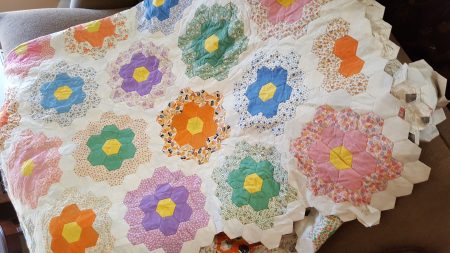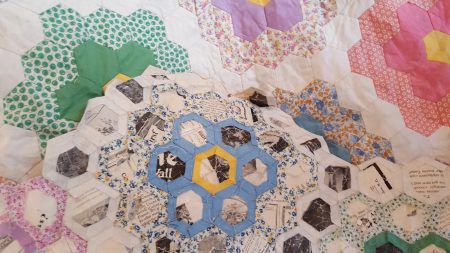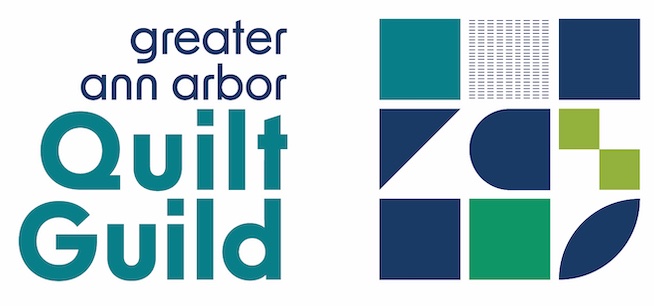 by GAAQG Preservationist Pam Young Setla, March 13, 2019
by GAAQG Preservationist Pam Young Setla, March 13, 2019
Vintage is a term that refers to quilts that are from the 1920s -1960s. These quilts are often mistakenly called antique by sellers and owners alike.
Former quilter Mary Jo Frank of Dexter recently gave me a vintage 1940s Grandmother’s Flower Garden quilt top and Dresden Plate orphan blocks made by her late grandmother, Lottie Staples. Her grandmother, who was raised on a farm in Michigan’s Tuscola County, left six to eight quilts to family members when she died.
“My grandmother lived on a farm seven miles east of Frankenmuth and made these quilts before I was born,” Frank said. “She hand-quilted most of them, probably when my father was away during World War II.”
The Grandmother’s Flower Garden pattern can be traced back to the 1780s – 1800s when English quilters would use beautiful dress prints and English paper piecing to form a rosette, surrounded by different colored hexagons. The hexagon quilts were left unquilted, unlike today.
The pattern went out of style until the 1850s, and then fell out of favor again until its resurgence during the 1930s-40s. Bright multi-colored prints and solids were now available. The color green was popular with variations like Nile green, mint green and sage. A rose pink, called bubble gum pink by today’s quilters, was often paired with green. Quilters also could choose fabrics in lemon yellow, canary yellow or a golden yellow that was usually paired with brown. By the 1940s, prints became busier.
Lottie Staples’ Grandmother’s Flower Garden quilt top features colors typical of this era. She creatively used ‘bubble gum’ pink, light blue, purple and various light prints. Each rosette was finished with a yellow center. She used the English paper piecing method for the hexagons and the paper is still visible, forming a strong foundation for each piece.
It is a beautiful quilt top that looks easy to make until you realize how talented and patient Mrs. Staples needed to be working with English paper piecing. That is a sign of a skilled quilter.
Pamela Young Setla is the Preservationist for the Greater Ann Arbor Quilt Guild and is working toward becoming a certified appraiser in antique quilts and textiles. She is a member of the American Quilt Study Group, the American Quilter’s Society, the Baltimore Applique Society, and the Quilt Guild of the British Isles


I have an unfinished Grandmother’s Flower Garden top and another top that was pieced by my great-grandmother or great-aunts. I have been debating what to do with them.
Hi, Loraine: you are lucky to have these tops. You have several options . You can lay the tops on your beds and just enjoy them or you can add a self binded bottom followed by machine or hand quilting the rosettes. You can finish them with a backing. With the Flower Garden top, you can then machine or hand applique around each “flower.”I have 13 orphan blocks (finished blocks that aren’t made into a top) from the 1860s. I am adding additional reproduction fabric to connect the blocks for a completed top. You can research how to finish the tops by looking at both modern and vintage quilt books. I have two recommendations: make sure you document as much information about the quilt as possible including the names of the quilters and the date if known. Second, if the quilt is finished except for the actual quilting, you have to date the quilt from the time you finished it. You would say, for example, the quilt was pieced in 1940 and quilted in 2001. Good luck and I hope to see your tops at the next meeting. It’s important that you write down the name of the quilter and the approximate dates of when the original blocks were made and when you completed the quilt. Enjoy these tops! (Note: edited to combine two comments. GAAQG)
Thanks for this article! Hexies have come and gone in popularity it seems. They certainly have made a come-back in the last several years.
Thanks, Katie. My sister is a Hexie nut and I bought her a new book that provides great patterns for using all those hexagons. I can’t remember the name, but I’m sure it is available on Amazon or at your local quilt shop.